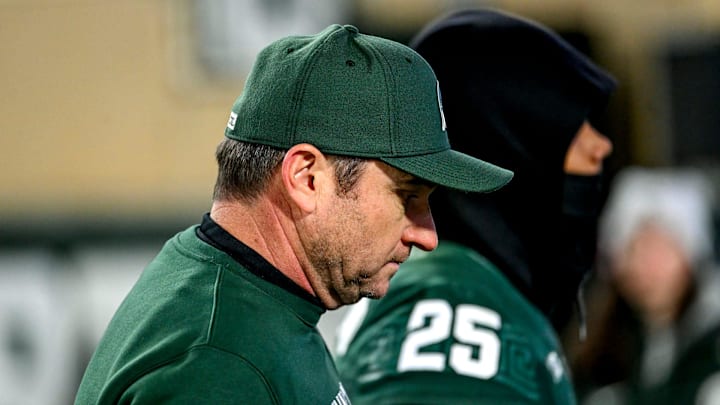Michigan State football has predicated itself on a complementary run-and-play-action-based offense and aggressive and stout defenses for as long as I can remember – a typical approach to Big Ten football.
It's part of what guided the Spartans to a multitude of upsets and drove the best seasons the program has seen. Recent years have fallen away from that. The defense took a step forward in last week's loss to Michigan as defensive coordinator Joe Rossi's presence on the sideline inspired the unit's best overall effort of the season.
But the offense turned in one of its worst performances, leaving fans dumbfounded by the lack of urgency and bland play-calling that has not worked for the last 19 games, not to mention the same mistakes by players that were supposed to have grown by now and the lackluster running game that was once such a massive part of the offense's success.
"It's frustrating because I know we have the tools to do it," team captain and starting center Matt Gulbin told the media this week. "We've just got to put it all together. ... We're going to continue working on it. We still have opportunities to get better, so we're going to take advantage of it and keep going."
When Jonathan Smith was hired, it seemed clear that the identity of this program was going to be rooted in recruiting and developing throughout the year, and driven by the passing offense on the field. After all, Smith himself was a former quarterback, and he was bringing a star, dual-threat signal caller with him to East Lansing.
Aidan Chiles was one of the spark-plugs for MSU in 2024, showing tantalizing arm talent and a running ability not traditionally ingrained in a Spartan quarterback. He struggled with turnovers in the first half of the season, but calmed down enough to finish the year with 2,415 yards and 13 touchdowns. He did throw 11 picks, but eight came in the season's first month.
Unfortunately, much of his recent play has revived concerns around those struggles to the point where some are now calling for his benching. He has had four games in 2025 with a completion rate under 60 percent and two with less than 100 passing yards, and fumbles have also become an issue.
What Is Aidan Chiles Biggest Problem? pic.twitter.com/oeV4JIp1CS
— 97.1 The Ticket: (@971theticketxyt) October 27, 2025
All offseason, we heard about how talented the receiving corps was going to be in 2025, and it gave us high hopes for the passing game and the offense's potential overall. MSU had a superstar sophomore returning in Nick Marsh and added transfers about whom coaches raved, including Omari Kelly, Rodney Bullard, and Chrishon McCray.
McCray and Kelly were both preseason Biletnikoff Award nominees, supposedly representing increased depth at the position as the team's nominees for the best receiver in the country, even though many didn't even consider either the best receiver on the team. While we've seen flashes from all these players, none have kept it up for significant time periods, and each has made crucial mistakes throughout the year.
Marsh leads the team with 479 receiving yards and five touchdowns this season, but there's too steep a drop-off after he and Kelly — the only two Spartans in the top 15 in the Big Ten. To make matters worse, only four Spartans rank among the top 500 receivers nationally, and there are quarterbacks with more receiving yards than Bullard.
As for Chiles, he ranks 14th in the Big Ten in passing yards (out of 18 teams), 11th in completion percentage, and 89th in passing yards nationally. That's not at all what most of us had in mind after hearing about the depth of this year's passing attack and the strides it had made.
“We’re definitely looking at it and searching as coaches,” Smith told the media this week. “You think about it because we’ve shown some flashes. … Just like every position, we’re evaluating what gives us the best chance. Those conversations are on a weekly basis, but we need more consistency and really just points from the offensive side – another touchdown or two per game.”
Wide receivers coach Courtney Hawkins compared the offensive system to the LA Rams and the Detroit Lions when this staff arrived in East Lansing, and we haven't seen anything close to those expectations.
A common thread in all those schemes is a productive running game. Sure, Jared Goff, Amon-Ra St. Brown, Matthew Stafford, Puka Nacua, etc., may get all the attention, but those systems don't work without the production they've gotten from Jahmyr Gibbs, David Montgomery, Kyren Williams, and the other running backs.
That was once a crucial part of MSU's offensive identity, too, but since Kenneth Walker left after the 2021 season, the Spartans have ranked among the worst teams in the country at running the football. This year's team is 14th in the Big Ten alone and 90th nationally, making it just that much more difficult for the Spartans to mold a decent and competitive offense.
It's probably too late for the current staff, but establishing an offensive identity and finding answers that have eluded the Spartans for the last four seasons should be a priority for the next boss. Getting back to program roots and the Big Ten style would be a good place to start.
